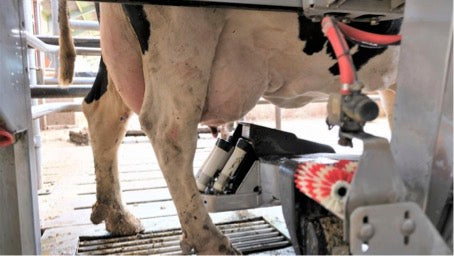The Liner is the contact between the milking machine and the cow. Liners differences in sizes, materials, brands, lifespan and functions. What the Liners have in common that it is an essential part of the milking system. However, the Liner a wearing part and will wear out over time. This wearing out can cause a Liner less effective milking and can even be harmful to the cows and milk production.
The role of the Liners
The Liners are the interface between the milking machine and the cow. The Liner is mounted in a milking cup. The milking cup is a casing of a hardened material such as plastic and metal. It is important that the milking cup and the Liner have a good fit and therefore fit together well.
The Liner creates a vacuum around the teat, which causes milk to be sucked out of the teat by means of a pulsating movement. Also known as opening and closing the liner with a suction force under the teat. Important here is a Liner that sufficiently massages the teat. Massaging the teat stimulates the cow's milk ejection reflex, causing the cow to let down her milk (Zwertvaegher & ILVO T&V Agrotechniek, 2010).
Signs of a worn out Liner
A Liner must be replaced within the recommended lifespan specified by the manufacturer. A Liner wears out and loses its elasticity. The material from which the Liner exists, determines the lifespan of the lining. For example, natural rubber lasts 600 to 800 milkings, while synthetic rubber lasts 1,200 to 2,500 milkings. The silicone Liner lasts for 3,000 to 5,000 milkings. A Liner wears out due to elastic movement of the pulsation stroke. This causes it to lose its elasticity. This is visible in the form of hairline cracks and deformation. In addition, the Liner cleaned with hot water and possibly an acidic cleaning agent. This requires a lot from the material, which makes the material thinner (Zwertvaegher & ILVO T&V Agrotechniek, 2010).
The importance of timely replacement
To avoid problems, it is essential to Liners replace them in time. By replacing them in time they can:
- Maintaining the health and well-being of their cows.
- Maximizing or maintaining milk productivity.
- Reduce/prevent the risk of mastitis or other health problems around the udder (Zwertvaegher & ILVO T&V Agrotechniek, 2010).
Impact Liner on health and productivity
Failure to replace a worn-out part in time Liner can have consequences for health as well as productivity at cows. Possible effects may include:
- Higher infection pressure: A worn out Liner can cause friction and irritation of the teat. This can damage the teat. at teat damage increases the risk of pathogens such as mastitis entering the animal. Diseases among animals are bad for the animal's welfare and cost the farmer money.
- Poorer teat condition: By milking with a worn out Liner can damage the teat. Overloading the teat can cause teat tip callus. Teat tip callus can lead to reduced production and painful milking processes (Neijenhuis, 1995).
- More residual milk left in the udder: Due to a worn out Liner the teat is not massaged enough, which results in insufficient stimulation for milking. This can cause the quarter to be insufficiently milked. As a result, residual milk remains in the quarter. This can lead to an increased risk of infections, reduced production and blocked milk ducts at the occurrence in regularity (Lely, nd).
- Slower milking: Can cause more teat stress which is bad for teat quality. In addition, longer milking can reduce the capacity of the robot. This reduces the free time and number of milkings of a Milking robot, off.
- Discomfort at the cows: A worn out Liner causes discomfort during the milking process. This can lead to increased stress levels at dairy cattle. This can weaken a cow's immune system and increase susceptibility to disease and infection (Bruckmaier & Blum, 1998).
Thanks to Corné from Zeelst
Bibliography:
Bruckmaier, R. M., & Blum, J. W. (1998). Oxytocin Release and Milk Removal in Ruminants. Journal of Dairy Science, 81(4), 939–949. https://doi.org/10.3168/jds.S0022-0302(98)75654-1
Lely. (nd). The importance of complete milking in relation to maintaining or achieving good udder health. Lely. Retrieved April 9, 2024, from https://www.lely.com/nl/advies/lely-consumables/udder-health-articles/the-importance-of-full-milking/#:
Neijenhuis, F. (1995). Teat tip callus in practice. Practical research on cattle, sheep and horses , 19–21. https://edepot.wur.nl/47496
Zwertvaegher, I., & ILVO T&V Agrotechniek. (2010, March 12). Striving for a correct Liner. Dairy cattle, 14–16. https://edepot.wur.nl/280518
